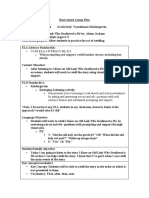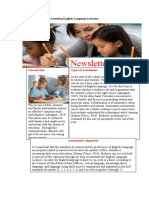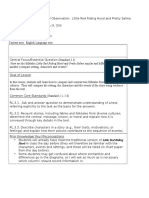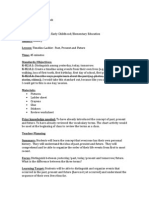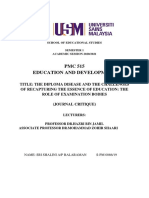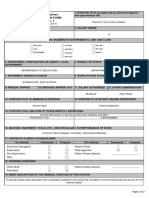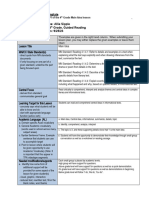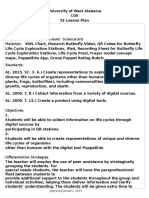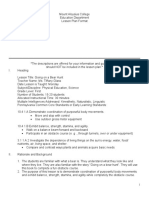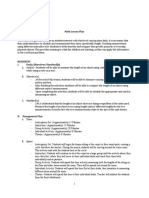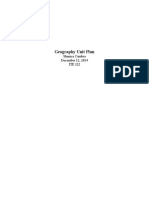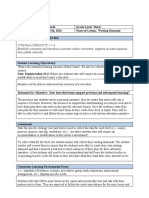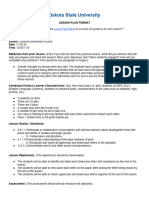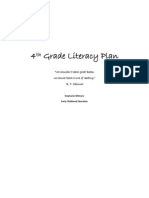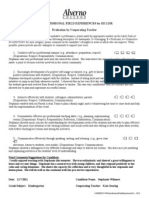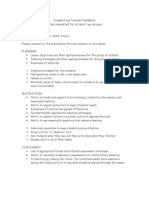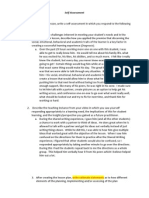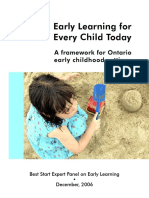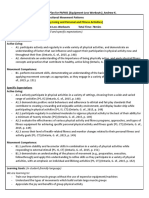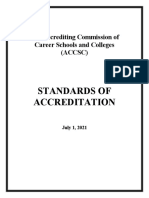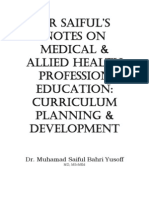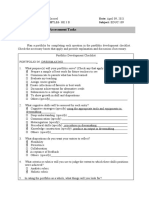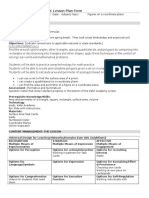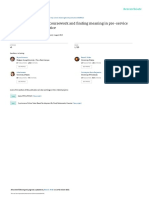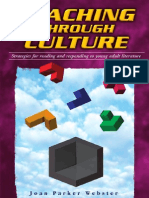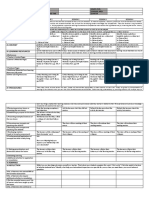Ed 215r Lesson 1 Stranger Danger
Ed 215r Lesson 1 Stranger Danger
Uploaded by
api-205910346Copyright:
Available Formats
Ed 215r Lesson 1 Stranger Danger
Ed 215r Lesson 1 Stranger Danger
Uploaded by
api-205910346Original Title
Copyright
Available Formats
Share this document
Did you find this document useful?
Is this content inappropriate?
Copyright:
Available Formats
Ed 215r Lesson 1 Stranger Danger
Ed 215r Lesson 1 Stranger Danger
Uploaded by
api-205910346Copyright:
Available Formats
ED 215R Lesson Plan #1 Stranger Danger Greendale K
Rationale: The second week of October is Safety Week. Students will be learning about fire safety, 911, walking/crossing the street, bike helmets, seat belts, safety in the home, and stranger danger. Today, we will be working on stranger danger. This lesson fits because in the fictional story Little Red Riding Hood, the character of the wolf is a great example of a stranger they may meet who appears to be friendly and helpful, but who has something more sinister in mind. The kindergarten curriculum states that children need to be introduced to making predictions as strategies to comprehend text. They will be introduced to predictions while reading this story. The students will make predictions on what they think will happen next, so they will be left with a better understanding of what is going on in this book and a better understanding of bad strangers.
Goals (Standards): CCSS.RL.K.1: With prompting and support, ask and answer questions about key details in a text. CCSS.RL.K.10: Actively engage in group reading activities with purpose and understanding. CCSS.SL.K.2: Confirm understanding of a text read aloud or information presented orally through other media by asking and answering questions about key details and requesting clarification if something is not understood.
Objective: The students will: Make predictions to understand the story. (focus of assessment) Have a better understanding of the concept stranger and why to not talk to strangers.
Assessment: I will take notes on each student, on a clipboard that has post-its on it, on the predictions they have made to the story through their participation. (Each group will be asked at some time throughout the story of what their predictions are for the next part of the story.)
Strategies for children requiring additional assistance: This is a multi-level learning experience that includes a read aloud, so all students should be able to actively engage in the learning. I will partner the students up and they will use the strategy of knee to knee, eye to eye (eekk) to relate and connect ideas throughout the lesson. I will remodel how to make predictions, if necessary, as I observe and interact with the children.
ED 215R Lesson Plan #1 Stranger Danger Greendale K
Materials Needed: Title: Little Red Riding Hood by Charles Perrault The story will be told from the book online - http://www.dltk-teach.com/rhymes/littlered/1.htm Security guards, fire fighters, teachers, people who work behind a desk, a mother with children, mail carriers Total Time Needed: 40 minutes Introduction: 5 minutes Demonstration/Participation: 5 minutes Participation (During Reading): 15 minutes Practice/Performance: 10 minutes Closure/Recap: 5 minutes
Procedures: 1. Introduction/Demonstration (before reading):
Have been learning about strategies readers use to understand what they are reading better. A strategy I use every time I read and that we will be working on today is prediction. Predicting while you are reading is very important because you are able to understand the story much better. You can make a prediction when you use clues from the story, such as pictures, along with connecting what you know already, to figure out what will happen next in a story. Predicting what will happen next in a story is one of my favorite strategies to use! Today we will be working on making predictions while reading Little Red Riding Hood by Charles Perrault and have a better understanding for why we should not talk to strangers. My PredictionNow, when I want to predict what will happen in this book, I can start by looking at the pictures. In this very first picture you see a little girl that has a red coat on and she is outside. This makes me think that she is going to go somewhere and that is it cold, because when it is cold outside I put a coat on too. When I was little I would visit my family very often, especially my Grandmother, I wonder if Little Red is going to visit her Grandmother too In the story Little Red Riding Hood, a little girl is walking to her grandmothers house and is stopped by a stranger she does not know. The stranger, the Wolf, asks her where she is going and tells him that she is going to her grandmothers house and points to where she lives. Raise your hands and tell me what you think of when I say the word stranger. Stranger: People you do not know or do not know very well.
ED 215R Lesson Plan #1 Stranger Danger Greendale K
Not all people unknown are dangerous, but we need to understand the difference between good and bad strangers.
If you think the wolf is a bad stranger, make a prediction in your head on what you think is going to happen next? (Have them press their nose to save their predictions.)
2. Participation (During reading) Begin reading PAUSE: Page 2explain what dawdle means (dawdle: waste time or be slow) STOP: Page 4 Little Red told the Wolf where she was going. The wolf is a stranger that she did not knowdo you think she should have told him where she was going? Turn to your eekk buddy and ask: What do you think will happen next? (ask 2 or 3 groups) (Assessment) STOP: Page 6The Wolf went through Grandmas things and put on a nightgown, her sleepy cap, and some of her perfume, and then jumped into Grandmas bed and pulled the cover over his nose. Why do you think the Wolf did this? Turn to your eekk buddy and ask: What do you think will happen next? (ask 2 or 3 groups) (Assessment) PAUSE: Page 9explain what frazzled means (frazzle: to be exhausted/tired) STOP: Page 9When Little Red realized that the Wolf was not her Grandmother, she ran across the room and through the door shouting as help as loud as she could. Would you have run out of the house and shouted for help? Turn to your eekk buddy and ask them: What do you think will happen next? (ask 2 or 3 groups) (Assessment) Engage in brief discussion about the textPersonal Reaction: o o What did you like best and why? What would you have done if you were Little Red Riding Hood? Why? (Assessment) 3. Practice/Performance In this story the Wolf was a bad stranger. Next time you read a book it may be about a good stranger. Can you raise your hands and predict who may be a good stranger? (Police officers, security guards, teachers, people who work behind a desk, a mother with children, mail carriers)
ED 215R Lesson Plan #1 Stranger Danger Greendale K
Each eekk group of students will be given a picture of a good stranger. I will ask them to predict what they believe will happen to Little Red Riding Hood if she met them instead of the Wolf. (while teacher assesses/circulates around the room) I will give them the example of if LRRH would have ran into a Police officer he might have told her that she should hurry and get to her Grandmothers house before a bad stranger tries to talk to her. The good officer will walk her to her Grandmothers house to make sure she gets there safe and then she will eat dinner with her Grandmother. (Demonstration) Pull children back together as a whole group in a circle around the carpet, and have each group share their predictions. 4. Closure/Recap Great job on making predictions! Readers make connections and predictions to help them understand the story more. The more you understand a story the more you enjoy it! Readers make connections and predictions whenever they can.
You might also like
- Read Aloud Lesson Plan FinalDocument2 pagesRead Aloud Lesson Plan Finalapi-305932987100% (1)
- Spe 615 Lesson 2 PlanDocument3 pagesSpe 615 Lesson 2 Planapi-302304245No ratings yet
- Bear LessonDocument10 pagesBear Lessonapi-341620347No ratings yet
- Lesson Plan Template For Residency Students 12-3Document5 pagesLesson Plan Template For Residency Students 12-3Tahtiana BrooksNo ratings yet
- Assessing English Language Learners Newsletter ESL 536 Week 6Document3 pagesAssessing English Language Learners Newsletter ESL 536 Week 6Jacqueline MedinaNo ratings yet
- Third Observed LessonDocument10 pagesThird Observed Lessonapi-313928713100% (1)
- Writing Lesson PlanDocument39 pagesWriting Lesson Planapi-482714429No ratings yet
- Seton Hill University Lesson Plan Template: Name Subject Grade Level Date/DurationDocument12 pagesSeton Hill University Lesson Plan Template: Name Subject Grade Level Date/Durationapi-266496943No ratings yet
- Adding Doubles Lesson PlanDocument4 pagesAdding Doubles Lesson PlanstacierconleyNo ratings yet
- 2 Unit Plan Overview DraftDocument4 pages2 Unit Plan Overview Draftapi-213547236No ratings yet
- Cinderella Lesson PlanDocument5 pagesCinderella Lesson Planapi-285768293No ratings yet
- Comparing Thicknesses of Paint and Adherence To Different Surfaces Art and Science LessonDocument3 pagesComparing Thicknesses of Paint and Adherence To Different Surfaces Art and Science Lessonapi-533736125100% (1)
- History Lesson PlanDocument4 pagesHistory Lesson Planx3jenny08No ratings yet
- PMC 515 Education and DevelopmentDocument22 pagesPMC 515 Education and DevelopmentShalini RamNo ratings yet
- Republic of The Philippines Position Description Form DBM-CSC Form No. 1Document2 pagesRepublic of The Philippines Position Description Form DBM-CSC Form No. 1Remelyn Cortes100% (4)
- Ib Lesson Plan-VocabularyDocument6 pagesIb Lesson Plan-Vocabularyapi-265303985No ratings yet
- Social Studies 2 Members of A CommunityDocument8 pagesSocial Studies 2 Members of A Communityapi-400451439No ratings yet
- Thunder Cake-RevisionsDocument7 pagesThunder Cake-Revisionshsmith15No ratings yet
- Lesson Plan Letter s-7Document6 pagesLesson Plan Letter s-7api-317065392No ratings yet
- Edtpa Main Idea Lesson Plan 1Document13 pagesEdtpa Main Idea Lesson Plan 1api-708704290No ratings yet
- Antonym LessonDocument2 pagesAntonym Lessonapi-273160985No ratings yet
- Lesson Plan PortfolioDocument26 pagesLesson Plan Portfolioapi-269837140No ratings yet
- Supervisor Ela Lesson PlanDocument8 pagesSupervisor Ela Lesson Planapi-477345968No ratings yet
- Reading Lesson Plan 2Document3 pagesReading Lesson Plan 2Harjit KaurNo ratings yet
- MassDocument2 pagesMassapi-222745762No ratings yet
- Math - Counting Numbers Lesson PlanDocument3 pagesMath - Counting Numbers Lesson PlanNicole dundonNo ratings yet
- Social Studies Lesson PlanDocument7 pagesSocial Studies Lesson Planapi-404999113No ratings yet
- Corduroy Read AloudDocument4 pagesCorduroy Read Aloudapi-283833776100% (1)
- Addition Lesson PlanDocument3 pagesAddition Lesson Planapi-29549876750% (2)
- 4th Grade NC Symbols Lesson PlanDocument7 pages4th Grade NC Symbols Lesson Planapi-25041716967% (3)
- Third Grade Lesson Plan MultiplicationDocument4 pagesThird Grade Lesson Plan MultiplicationkimNo ratings yet
- Direct Instruction Lesson Plan Template: Ccss - Ela-Literacy.L.1.4.BDocument3 pagesDirect Instruction Lesson Plan Template: Ccss - Ela-Literacy.L.1.4.Bapi-405196113No ratings yet
- 5e Lesson Plan 1Document7 pages5e Lesson Plan 1api-337151712100% (1)
- Writing LessonpdfDocument11 pagesWriting Lessonpdfapi-402570316No ratings yet
- Indiana Wesleyan University Science Lesson Plan Sara Eubank Lesson RationaleDocument5 pagesIndiana Wesleyan University Science Lesson Plan Sara Eubank Lesson Rationaleapi-489828484No ratings yet
- Analytical PhonicsDocument6 pagesAnalytical PhonicsI-Reen FrancisquiteNo ratings yet
- Weather UnitDocument22 pagesWeather Unitapi-357354808No ratings yet
- Lesson 3 5Document5 pagesLesson 3 5api-336460917No ratings yet
- EdTPA Lesson PlanDocument6 pagesEdTPA Lesson PlanStephen Schultheis0% (1)
- Bear Hunt ReflectionDocument4 pagesBear Hunt Reflectionapi-478596695No ratings yet
- Unit Lesson 1Document6 pagesUnit Lesson 1api-566153686No ratings yet
- Whole Group Lesson PlanDocument6 pagesWhole Group Lesson Planapi-283325243No ratings yet
- Compare and Contrast Lesson PlanDocument2 pagesCompare and Contrast Lesson PlanMaryBeth LynnNo ratings yet
- A Detailed Lesson Plan in English IIIKrysette GalaDocument9 pagesA Detailed Lesson Plan in English IIIKrysette GalanickeltrimmerNo ratings yet
- Math Lesson Plan 2Document12 pagesMath Lesson Plan 2api-456889650No ratings yet
- Ugly Duckling. First GradeDocument6 pagesUgly Duckling. First GradeMaguie SarmientoNo ratings yet
- Teacher Work Sample Final 2Document55 pagesTeacher Work Sample Final 2api-348361949No ratings yet
- Geography Unit PlanDocument11 pagesGeography Unit Planapi-318180731No ratings yet
- Fluency Lesson PlanDocument6 pagesFluency Lesson Planapi-231626780No ratings yet
- Lesson 1 - Story StructureDocument4 pagesLesson 1 - Story StructureAnonymous Z9zcD6BzNo ratings yet
- Lesson Plan 3 Modified fs1Document1 pageLesson Plan 3 Modified fs1api-212740470No ratings yet
- Picture CompositionDocument3 pagesPicture CompositionManojNo ratings yet
- Small Group Lesson Plan FishingDocument4 pagesSmall Group Lesson Plan Fishingapi-594519491No ratings yet
- Lesson Plan For Emergent Literacy Lesson PortfiloDocument3 pagesLesson Plan For Emergent Literacy Lesson Portfiloapi-349892929No ratings yet
- Lesson Plans For Learning SegmentDocument12 pagesLesson Plans For Learning Segmentapi-353068872No ratings yet
- Picture Comprehension DESCRIPTIONDocument2 pagesPicture Comprehension DESCRIPTIONSumaira KhanNo ratings yet
- Lesson Plan - Little Red Hen: Comprehending: SequenceDocument2 pagesLesson Plan - Little Red Hen: Comprehending: Sequenceapi-375889476No ratings yet
- PTP - Lesson PlanDocument22 pagesPTP - Lesson PlanAzrul Aswad Abu BakarNo ratings yet
- Unit Plan Main IdeaDocument16 pagesUnit Plan Main IdeaGreta LautenschuetzNo ratings yet
- HalloweenfinalDocument33 pagesHalloweenfinalapi-285176118No ratings yet
- Little Red Riding HoodDocument4 pagesLittle Red Riding HoodCatherine LeeNo ratings yet
- Ahora No Bernardo David McKeeDocument9 pagesAhora No Bernardo David McKeeLuz Mery LopezNo ratings yet
- 4th Grade Literacy PlanDocument40 pages4th Grade Literacy Planapi-205910346100% (2)
- Real ResumeDocument1 pageReal Resumeapi-205910346No ratings yet
- Math Lesson 2 - 4th GradeDocument4 pagesMath Lesson 2 - 4th Gradeapi-205910346No ratings yet
- Categories of Vertebrates: 1 Grade Science Unit PlanDocument7 pagesCategories of Vertebrates: 1 Grade Science Unit Planapi-205910346No ratings yet
- Cooperatingteacherevaluationform Ed 215rDocument2 pagesCooperatingteacherevaluationform Ed 215rapi-205910346No ratings yet
- Ta 355 - FinalDocument9 pagesTa 355 - Finalapi-205910346No ratings yet
- Ed 225 Final Literacy PlanDocument26 pagesEd 225 Final Literacy Planapi-205910346No ratings yet
- Atpa Phase IIDocument3 pagesAtpa Phase IIapi-205910346No ratings yet
- Ed 338 Kindergarten Unit PlanDocument19 pagesEd 338 Kindergarten Unit Planapi-205910346No ratings yet
- Feedback On Clock LessonDocument1 pageFeedback On Clock Lessonapi-205910346No ratings yet
- Atpa Phase III Self-AssessmentDocument3 pagesAtpa Phase III Self-Assessmentapi-205910346No ratings yet
- Ed 338 Lesson 4 Self AssessmentDocument4 pagesEd 338 Lesson 4 Self Assessmentapi-205910346No ratings yet
- Allama Iqbal Open University: Assignment No. 2Document18 pagesAllama Iqbal Open University: Assignment No. 2Sadiq MazariNo ratings yet
- Early Learning For Every Child TodayDocument111 pagesEarly Learning For Every Child TodayGurjinderPannuNo ratings yet
- Science Teachers EvaluationDocument3 pagesScience Teachers EvaluationMay KhalidNo ratings yet
- Classroom Assessments - Checklists, Ratings Scales and RubricsDocument78 pagesClassroom Assessments - Checklists, Ratings Scales and RubricsSai Theebann50% (2)
- TO Chapter 9 Stand by MeDocument7 pagesTO Chapter 9 Stand by MeFaezal AhmedNo ratings yet
- Rubric For Effection Teacher Technology IntegrationDocument11 pagesRubric For Effection Teacher Technology Integrationapi-343244245100% (1)
- Equipment-Less Workouts 3 Part Lesson Plan For Paf401 Andrew KDocument5 pagesEquipment-Less Workouts 3 Part Lesson Plan For Paf401 Andrew Kapi-532877681No ratings yet
- Algebra II Probability Unit Plan HoganDocument12 pagesAlgebra II Probability Unit Plan Hoganapi-308627801No ratings yet
- Learning Theories IntroductionDocument89 pagesLearning Theories IntroductionMARIA JOSE I�IGUEZ ROBLESNo ratings yet
- General Methods of Teaching: Submitted By: Ayesha Khalid Assignment Number 1 B.ED 1.5 YearDocument20 pagesGeneral Methods of Teaching: Submitted By: Ayesha Khalid Assignment Number 1 B.ED 1.5 YearAyesha KhalidNo ratings yet
- Feedback Log For AsessmentsDocument4 pagesFeedback Log For Asessmentsapi-604788824No ratings yet
- ACCSC Standards of Accreditation and Bylaws 070121Document158 pagesACCSC Standards of Accreditation and Bylaws 070121omaima mohamedNo ratings yet
- DR Saiful's Notes On Medical - Allied Health Education - Curriculum Planning - DevelopmentDocument71 pagesDR Saiful's Notes On Medical - Allied Health Education - Curriculum Planning - DevelopmentAdrest S MamuroNo ratings yet
- Module 2: Lesson 3 Assessment TasksDocument4 pagesModule 2: Lesson 3 Assessment TasksJayson100% (1)
- Coordinate PlanesDocument3 pagesCoordinate Planesapi-300394682No ratings yet
- ABPL90316 The Shaping of Urban Design: Credit Points: Level: Dates & LocationsDocument2 pagesABPL90316 The Shaping of Urban Design: Credit Points: Level: Dates & Locationschemistry-rocketNo ratings yet
- Final Buerkley FS 1 TG Sas Weeks 7 12Document33 pagesFinal Buerkley FS 1 TG Sas Weeks 7 12Shaina IbeNo ratings yet
- PCK2 - ASSESSMENT OF SL 1 Finals 1st SessionDocument13 pagesPCK2 - ASSESSMENT OF SL 1 Finals 1st SessionAngelo CentenoNo ratings yet
- Etrd 2015Document22 pagesEtrd 2015GayaniNo ratings yet
- Part 1 Partial Lesson Plan Assignment AssessmentDocument4 pagesPart 1 Partial Lesson Plan Assignment Assessmentapi-539511923No ratings yet
- s13 Te876 Module 5-Lesson PlanDocument8 pagess13 Te876 Module 5-Lesson Planapi-278415397No ratings yet
- IGSCE Booklet 2022 2024Document62 pagesIGSCE Booklet 2022 2024BPuji KYD100% (1)
- Teaching Through Culture: Strategies For Reading and Responding To Young Adult Literature by Dr. Joan Parker WebsterDocument194 pagesTeaching Through Culture: Strategies For Reading and Responding To Young Adult Literature by Dr. Joan Parker WebsterArte Público Press100% (2)
- I ObjectivesDocument3 pagesI ObjectivesPeache Nadenne LopezNo ratings yet
- Learn Aspen Plus in 24 Hours WorkshopDocument52 pagesLearn Aspen Plus in 24 Hours WorkshopSyahmi Abdullah100% (2)
- Asl My EssayDocument27 pagesAsl My EssayGar Sor0% (1)
- Final Module in P.EDocument6 pagesFinal Module in P.EEuticquio NaquimenNo ratings yet
